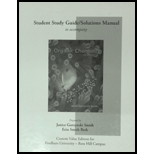
Concept explainers
(a)
Interpretation: The structure corresponding to the given name is to be stated.
Concept introduction: International Union of Pure and Applied Chemistry gave guidelines to write the chemical name of molecules. There are three steps to derive the structure of the compound from its IUPAC name. The first step involves the identification of the parent name and the functional group found at the end of the name. The second step is numbering of carbon skeleton in either direction. The third step is the addition of substituents at appropriate carbon atoms.
Answer to Problem 19.29P
The structure corresponding to
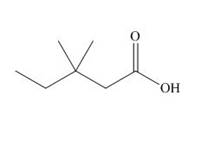
Explanation of Solution
The name of the compound is
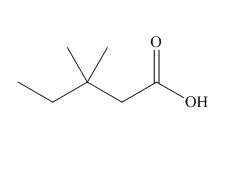
Figure 1
The structure of
(b)
Interpretation: The structure corresponding to the given name is to be stated.
Concept introduction: International Union of Pure and Applied Chemistry gave guidelines to write the chemical name of molecules. There are three steps to derive the structure of the compound from its IUPAC name. The first step involves the identification of theparent name and the functional group found at the end of the name. The second step is numbering of carbon skeleton in either direction. The third step is the addition of substituents at appropriate carbon atoms.
Answer to Problem 19.29P
The structure corresponding to

Explanation of Solution
The name of the compound is

Figure 2
The structure of
(c)
Interpretation: The structure corresponding to the given name is to be stated.
Concept introduction: International Union of Pure and Applied Chemistry gave guidelines to write the chemical name of molecules. There are three steps to derive the structure of the compound from its IUPAC name. The first step involves the identification of theparent name and the functional group found at the end of the name. The second step is numbering of carbon skeleton in either direction. The third step is the addition of substituents at appropriate carbon atoms.
Answer to Problem 19.29P
The structure corresponding to
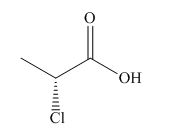
Explanation of Solution
The name of the compound is
The stereochemistry of the compound is determined by prioritizing the groups attached to its stereogenic center. The groups are prioritizedon the basis ofatomic number of their atoms. The configuration of the compound is
Therefore, the structure corresponding to the given name is,

Figure 3
The structure of
(d)
Interpretation: The structure corresponding to the given name is to be stated.
Concept introduction: International Union of Pure and Applied Chemistry gave guidelines to write the chemical name of molecules. There are three steps to derive the structure of the compound from its IUPAC name. The first step involves the identification of theparent name and the functional group found at the end of the name. The second step is numbering of carbon skeleton in either direction. The third step is the addition of substituents at appropriate carbon atoms.
Answer to Problem 19.29P
The structure corresponding to
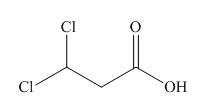
Explanation of Solution
The name of the compound is
Therefore, the structure corresponding to the given name is,

Figure 4
The structure of
(e)
Interpretation: The structure corresponding to given name is to be stated.
Concept introduction: International Union of Pure and Applied Chemistry gave guidelines to write the chemical name of molecules. There are three steps to derive the structure of the compound from its IUPAC name. The first step involves the identification of theparent name and the functional group found at the end of the name. The second step is numbering of carbon skeleton in either direction. The third step is the addition of substituents at appropriate carbon atoms.
Answer to Problem 19.29P
The structure corresponding to
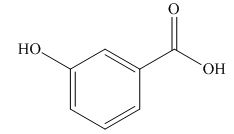
Explanation of Solution
The name of the compound is

Figure 5
The structure of
(f)
Interpretation: The structure corresponding to given name is to be stated.
Concept introduction: International Union of Pure and Applied Chemistry gave guidelines to write the chemical name of molecules. There are three steps to derive the structure of the compound from its IUPAC name. The first step involves the identification of theparent name and the functional group found at the end of the name. The second step is numbering of carbon skeleton in either direction. The third step is the addition of substituents at appropriate carbon atoms.
Answer to Problem 19.29P
The structure corresponding to

Explanation of Solution
The name of the compound is

Figure 6
The structure of
(g)
Interpretation: The structure corresponding to the given name is to be stated.
Concept introduction: International Union of Pure and Applied Chemistry gave guidelines to write the chemical name of molecules. There are three steps to derive the structure of the compound from its IUPAC name. The first step involves the identification of theparent name and the functional group found at the end of the name. The second step is numbering of carbon skeleton in either direction. The third step is the addition of substituents at appropriate carbon atoms.
Answer to Problem 19.29P
The structure corresponding topotassium acetate is,
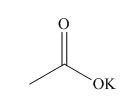
Explanation of Solution
The name of the compound is potassium acetate. The name suggests that potassium is present in the place of hydrogen in acetic acid. Therefore, the structure corresponding to the given name is,

Figure 7
The structure of potassium acetate is drawn in Figure 7.
(h)
Interpretation: The structure corresponding to the given name is to be stated.
Concept introduction: International Union of Pure and Applied Chemistry gave guidelines to write the chemical name of molecules. There are three steps to derive the structure of the compound from its IUPAC name. The first step involves the identification of theparent name and the functional group found at the end of the name. The second step is numbering of carbon skeleton in either direction. The third step is the addition of substituents at appropriate carbon atoms.
Answer to Problem 19.29P
The structure corresponding tosodium

Explanation of Solution
The name of the compound is sodium

Figure 8
The structure of sodium
(i)
Interpretation: The structure corresponding to the given name is to be stated.
Concept introduction: International Union of Pure and Applied Chemistry gave guidelines to write the chemical name of molecules. There are three steps to derive the structure of the compound from its IUPAC name. The first step involves the identification of theparent name and the functional group found at the end of the name. The second step is numbering of carbon skeleton in either direction. The third step is the addition of substituents at appropriate carbon atoms.
Answer to Problem 19.29P
The structure corresponding to

Explanation of Solution
The name of the compound is

Figure 9
The structure of
(j)
Interpretation: The structure corresponding to the given name is to be stated.
Concept introduction: International Union of Pure and Applied Chemistry gave guidelines to write the chemical name of molecules. There are three steps to derive the structure of the compound from its IUPAC name. The first step involves the identification of theparent name and the functional group found at the end of the name. The second step is numbering of carbon skeleton in either direction. The third step is the addition of substituents at appropriate carbon atoms.
Answer to Problem 19.29P
The structure corresponding to
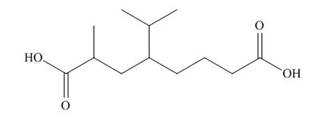
Explanation of Solution
The name of the compound is
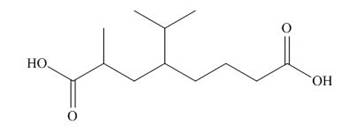
Figure 10
The structure of
Want to see more full solutions like this?
Chapter 19 Solutions
Organic Chemistry -Study Guide / Solution Manual (Custom)
- Rank the following compounds (an SN2 reaction with NaCN) with 1(the fastest reaction) and 4(slowest.)arrow_forwardWhat reagent can be used from compound F to G? (NaH / NaOH / LiAlH4+hydronium quench / CrO3 Jones)arrow_forward(a) Explain why an alkylamine is more basic than ammonia?(b) How would you convert(i) Aniline to nitrobenzene (ii) Aniline to iodobenzenearrow_forward
- Rank the following compounds from the least basic to the most basicarrow_forwardI don’t get how to get the last one. I don’t use too many complicated reagents. But I have no idea how to do this. (B) onlyarrow_forwarddraw out a step by step mechansim with arrows to get from the compound on the lefts to get the compound on the right and explainarrow_forward
- OChem help with IUPAC names involving Ph and Bn The phenyl group (Ph-R, C6H5-R) can be formed by removing a hydrogen from benzene and attaching a substituent to where the hydrogen was removed. The benzyl group (abbv. Bn), similar to the phenyl group, is formed by manipulating the benzene ring. In the case of the benzyl group, it is formed by taking the phenyl group and adding a CH2 group to where the hydrogen was removed. Its molecular fragment can be written as C6H5CH2-R, PhCH2-R, or Bn-R. Please provide the IUPAC name for the following: (Ph)2CHC(CH3)2CC(CH2)3CH(Bn)CHOarrow_forwardneed help with providing a good reagentarrow_forwardWhat steps are needed to convert A to B?arrow_forward
 Organic Chemistry: A Guided InquiryChemistryISBN:9780618974122Author:Andrei StraumanisPublisher:Cengage Learning
Organic Chemistry: A Guided InquiryChemistryISBN:9780618974122Author:Andrei StraumanisPublisher:Cengage Learning Chemistry for Today: General, Organic, and Bioche...ChemistryISBN:9781305960060Author:Spencer L. Seager, Michael R. Slabaugh, Maren S. HansenPublisher:Cengage Learning
Chemistry for Today: General, Organic, and Bioche...ChemistryISBN:9781305960060Author:Spencer L. Seager, Michael R. Slabaugh, Maren S. HansenPublisher:Cengage Learning


